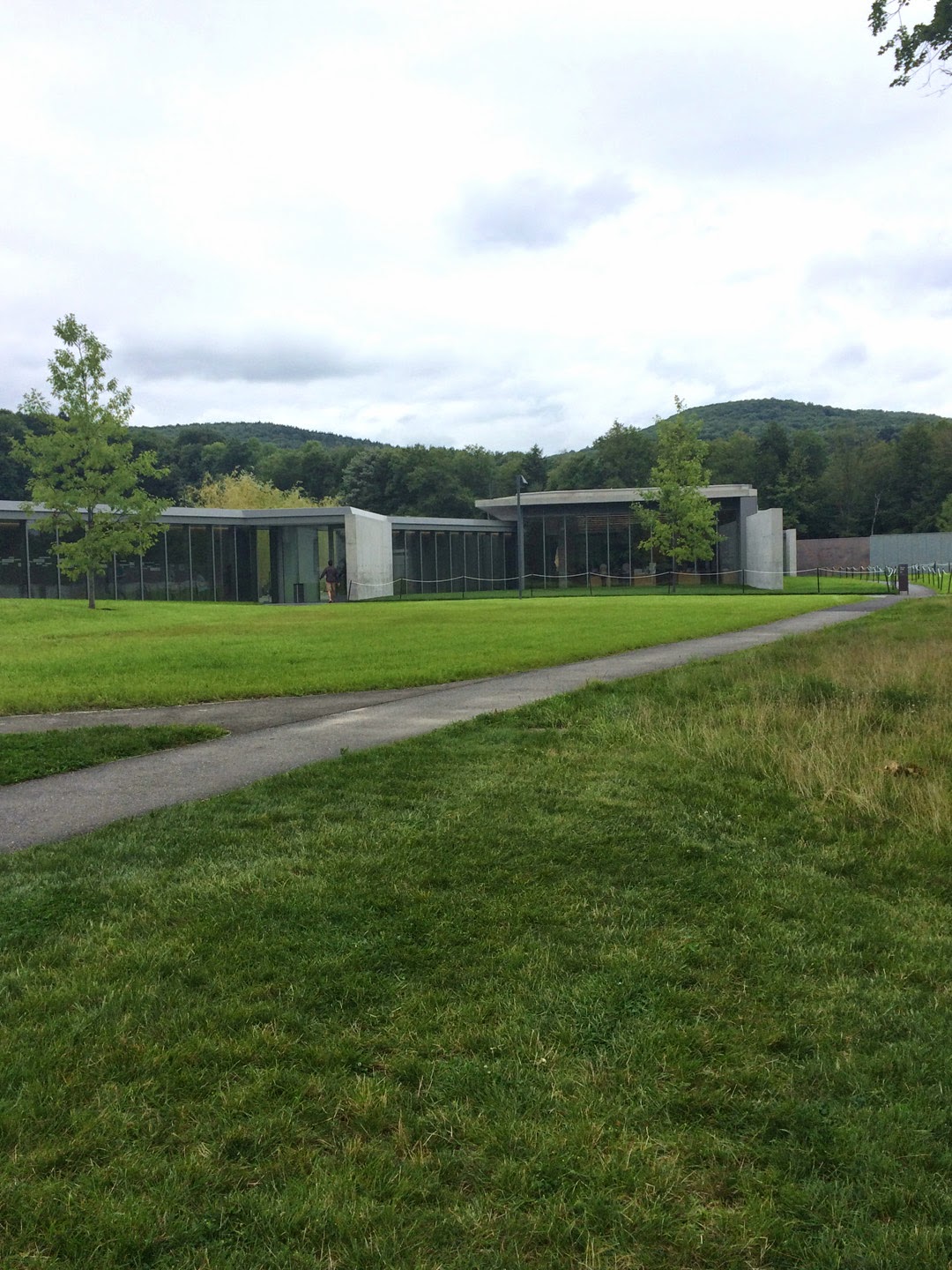Make It New: Abstract Painting From The National Gallery of Art, 1950-1975
Before showing you my amateur iPhone pictures, I recommend that for professional views you take a look at some links: the Clark's Facebook images of the show and also a review by Cate McQuaid in the Boston Globe with beautiful pictures.
So we are in the first gallery of the show that consists of 35 paintings curated from the National Gallery's collection by its curator, Harry Cooper.
 |
| Viewers in front of Jackson Pollock painting, Number 1, 1950, (Lilac Mist). |
 |
| Detail of "Lilac Mist" surface |
When you enter the gallery, you are facing Pollock's painting. Other works in this gallery are by Pollock's contemporaries - Rothko, Newman, Kline, Still and Joan Mitchell. The Mitchell work faces the Pollock.
 |
| Joan Mitchell, "Piano mechanique," 1958, oil on canvas, with two details. |
I was excited to see this work because I had only seen Mitchell's later work in person. As her work progressed, it became much more fluid and less what Cate McQuaid calls "effortful." Still, the number and variety of marks she makes plus the amount of color grounded by black in this work, make it much more interesting to me than the Pollock. And she's a woman painter among all those guys, making me pleased to see her confronting Pollock.
 |
| The Color Field Painting Gallery |
Color Field Painting
I've never been that interested in the stained form of color field painting, and I thought the most interesting work in this gallery was the one by Larry Zox, you can see it on the left wall of this gallery in the image above.
 |
| Larry Zox, "Decorah (Single Gemini Series), 1968, acrylic on canvas |
Zox's work looks very contemporary. It conveys the interesting illusion of folding in at the center when you stand in front of it because of the triangles pressing in from all sides.
 |
| Daniel Buren, "white acrylic paint on white and blue striped cloth," 1970. |
The small corner work by Buren was also unexpectedly contemporary, from its placement, to its raw edges to its installation with push pins. (I'm not sure that it was in the Color Field gallery, but I'm putting it here to relate to the Zox work.)
Pattern, Texture, Shape and Other Categories
Probably to make the work more accessible, paintings were sorted in this show by technique or prominent feature. However, as I look back on my photos, I can make no sense of where one began and the other left off because I don't agree with the distinctions. So I'm just going to put works together as they make sense to me.
The highlight of one gallery ("Pattern", "Shapes"?) to me was the work by Al Loving. He seemed like an old friend because I had presented his work in my talk on bricolage at the Encaustic Conference last June. Since my image was not very good, the one below is from Cate McQuaid's review in the Boston Globe.
 |
| Al Loving, "Brownie, Sunny, Dave & Al," 1972. ESTATE OF AL LOVING, COURTESY GARTH GREENAN GALLERY |
 |
| Frank Stella, "Delta," 1958, enamel on canvas |
Frank Stella's piece made an interesting complementary to the Loving work. I had never seen this work in person and didn't realize that it had such a shiny, gooey look that I think adds to it and relates it more to Ab-Ex.
 |
| Marcel Broodthaers, "Panneau de Moules (Panel of Mussels), 1966, mussel shells, resin and paint on panel |
Another bricolage work, that drew everyone to it to see if was really shells on panel, was this great piece that has such wonderful texture. My photo is lousy but you can see the shadow below of the ragged forms.
 |
| Yayoi Kusama, "Infinity Nets Yellow," 1960, oil on canvas |
This is just one section of Kusama's very large painting this consists of yellow circles painted on a dark ground. There is relatively little texture but the obsessive pattern is mesmerizing.
Of course I am leaving out many very well known works from the show, but I am just choosing my favorites and Lee Bontecou is right up there at the top of my list.
 |
| Lee Bontecou, Untitled, 1962, welded iron, canvas, wire and black paint |
I love being able to see the stains, marks of wear, and patches on the worn canvas she used along with the tiny copper wires holding the canvas onto the welded iron. The photo doesn't show it, but when I looked into that gaping black hole of eternity, I could see a little light at the seam.
Emerging to Nature, Restricted
 |
| Paved terrace with reflecting pool and willows |
 |
| Terrace with reflecting pool and roped-off grass. |
Gee, doesn't that grass look inviting? Well, forget about it!
 |
| I think this is the real front door. We saw it on our way out. |
 |
| A hidden corner |
 |
| A sea of grass being mowed by one guy with a push mower. |
 |
| Road to the back parking lot |
 |
| Mind the rope and forget about that grass! |











































